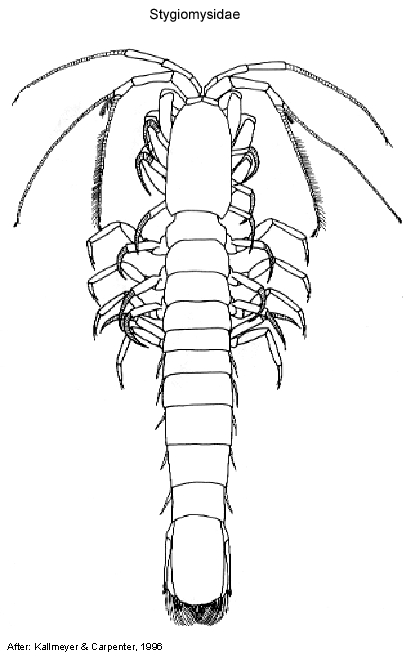 |
||||||
|
|
|
|
|
|
Mysidacea: Families, Subfamilies and TribesKenneth MelandStygiomysidae Caroli, 1937 Diagnostic description. Head. Carapace small, last 4 thoracic somites exposed dorsally. Rostrum obtuse. Eyes reduced (without trace of of pigment or visual elements). Antenna (antenna 2) scale reduced (bearing four spines). Labrum symmetric. Mandible lacinia mobilis well developed, spine row present between lacinia mobilis and molar process, molar process well developed (small but well chitinized). Thorax. 1st maxilliped exopod small, unarticulated. 2nd thoracopod developed as a gnathopod, exopod well developed. 3rd thoracopod forming a gnathopod. 4th thoracopod forming a gnathopod. 3rd-8th thoracopods endopod with distinct carpus and propodus, propodus unsegmented. Branchiae on thoracopods absent. Marsupium composed of seven pairs of oostegites (only four have been observed. Since four oostegites is quite exceptional for the Mysidacea, a full complement of seven oostegites as observed in Lepidomysidae is expected if a ovigerous female is found.). Abdomen 6th & 7th abdominal somites fused. Female pleopods biramous (as found in the male). Uropod endopod setose around entire margin, statocyst absent; exopod complete, outer margin entire (ending in two distal spines). Telson apex entire. Generic composition. Stygiomysidae contains 1 genus (6 species): Stygiomysis Caroli, 1937 (6 species). Remarks. The Stygiomysida families Lepidomysidae and Stygiomysidae where originally placed within the sub-order Mysida (see Gordan, 1960), where Tchindonova (1981) has later erected the sub-order Stygiomysida removing Lepidomysidae and Stygiomysidae from the Mysida. The Stygiomysidae are cavernicolous mysids described from the Dominican Republic, Caribbean Sea, Otranto, Italy and Jamaica.
Cite this publication as: 'Meland, K. (2002 onwards). Mysidacea: Families, Subfamilies and Tribes. Version 1: 2 October 2002. https://crustacea.net'. |
|
|
|
|
|
|
|
|
|
Copyright © Australian Museum, 2002 - 2003
Australian Museum website
